March 2021
By Steve Cary
I can’t dive into today’s topic without some big “Thank Yous” and a heads-up. Thanks to Bill Beck, Jim Brock, Matt Brown, Bill Dempwolf, Rebecca Gracey, Cathryn Hoyt, Ken Kertell, and Joe Schelling for responding to my photo requests so promptly and effectively. Significant holes were filled and Butterflies of New Mexico looks more complete and more beautiful than ever. Thanks, you guys!
Second, Marcy and I recently completed a fun, late February/early March trip to the area covered by this Rites of Spring II post. I will write up that adventure for a future post. Meanwhile, this present effort has been in the queue for several weeks and I want to get it out. In doing so, however, I must note that the spring hilltoppers phenomenon described is expressed to different degrees in different years and at different localities. My very recent scouting of the geographic area involved suggests this will not be a “10” year for our desert’s spring hilltoppers, but more likely a 1 or a 2, due to pervasive, severe drought. If you go, you may very well see some of the players, but in small numbers.
With that caveat, here we go . . .
After overwintering as pupae, several species of whites and orangetips eclose in early spring and immediately set about searching for mates on desert hilltops. This group includes Spring White, Desert Orangetip, Southwestern Orangetip, and Desert Marble. Why the rush? Well, they must place eggs on particular native mustards (Brassicaceae), which are among the first plants to green up in spring, first to flower, and first to senesce. How fast do they senesce? Well, not for nothing is a domesticated relative, arugula, called “rocket.” They come and go quickly. To complete their one annual generation, larvae of these butterflies must finish their growth and pupate before the host mustards senesce, turn dry, brown, and undigestible. Successful individuals pupate and go into diapause, a state of dormancy, which for them lasts through summer, autumn, and winter.
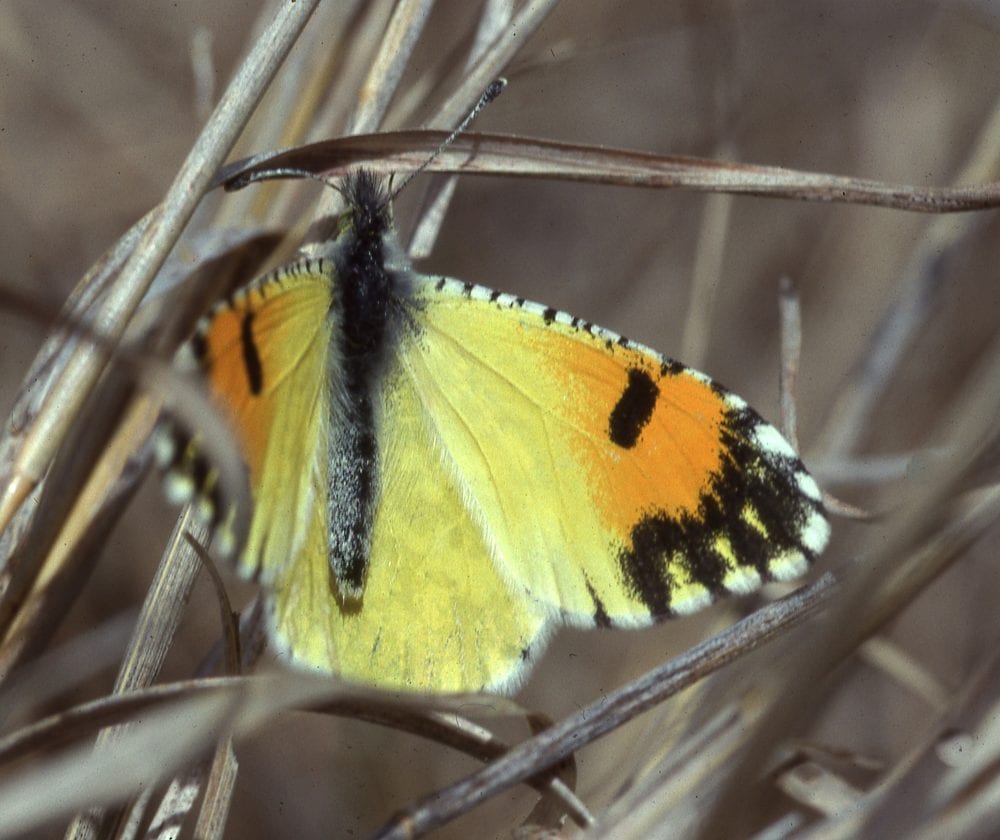

This guild’s collective reliance on spring mustards creates a shared immediacy to find mates and get eggs onto sprouting mustards so their offspring have enough time to complete development. From March into April, the country between I-10 and the Mexico border has many hilltops that can, when conditions are right, come alive with Southwestern Orangetips, Desert Orangetips, Spring Whites, and Desert Marbles, not to mention their ubiquitous, multiple-brooded cousin, Checkered White.
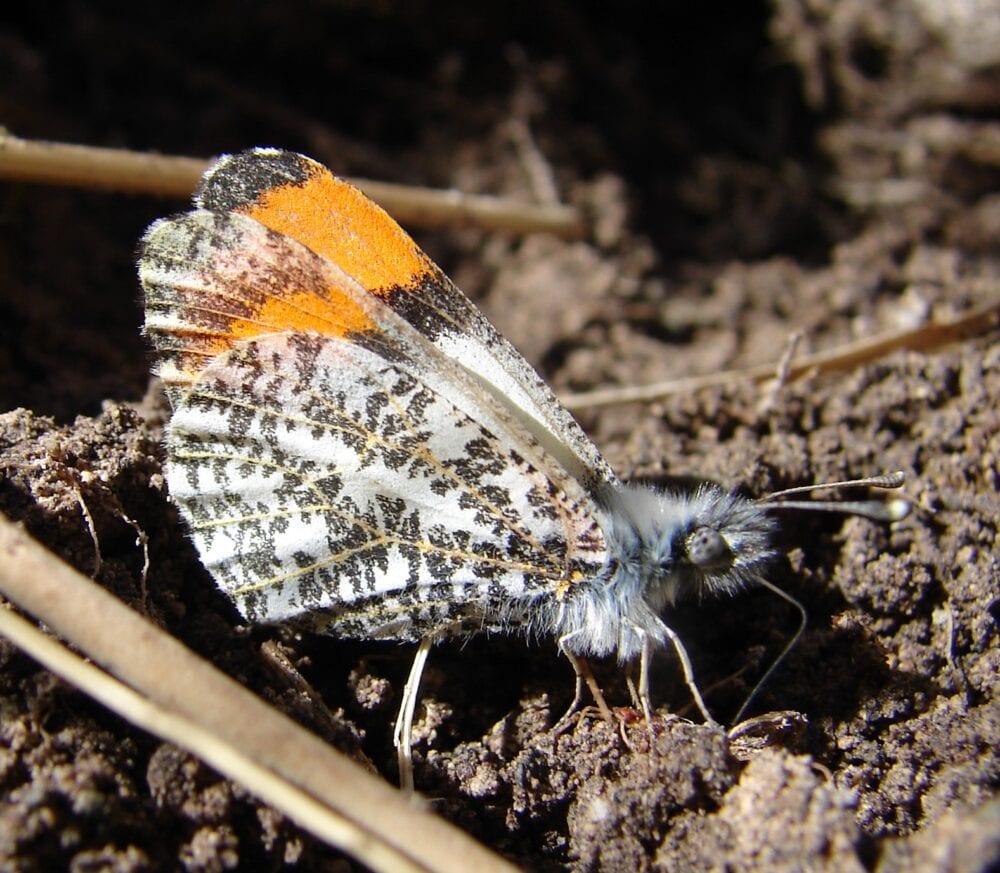

How do butterflyers get into the party? It’s not difficult once you get to the right part of the world. Modest hilltops work just fine; no need to perform a technical ascent of Organ Needle or Cooke’s Peak. At the other extreme, tiny bumps might work, but their lack of prominence means that most don’t pull hilltoppers from a very large ‘butterflyshed.’ The best plan is to find something in the middle, a medium hill whose summit is at least a half-mile from the next summit. Such a place will attract hilltopping males from that topographic radius. The area south of I-10 has many modest summits that can be walked up, exercising due care for land ownership, spiny plants, ankle-bending terrain, and an occasional basking rattlesnake. You could very well curse a blue streak on the way up your first hill, as I did, but lo and behold, it was worth the effort. Now hilltops are an important part of all my outings.
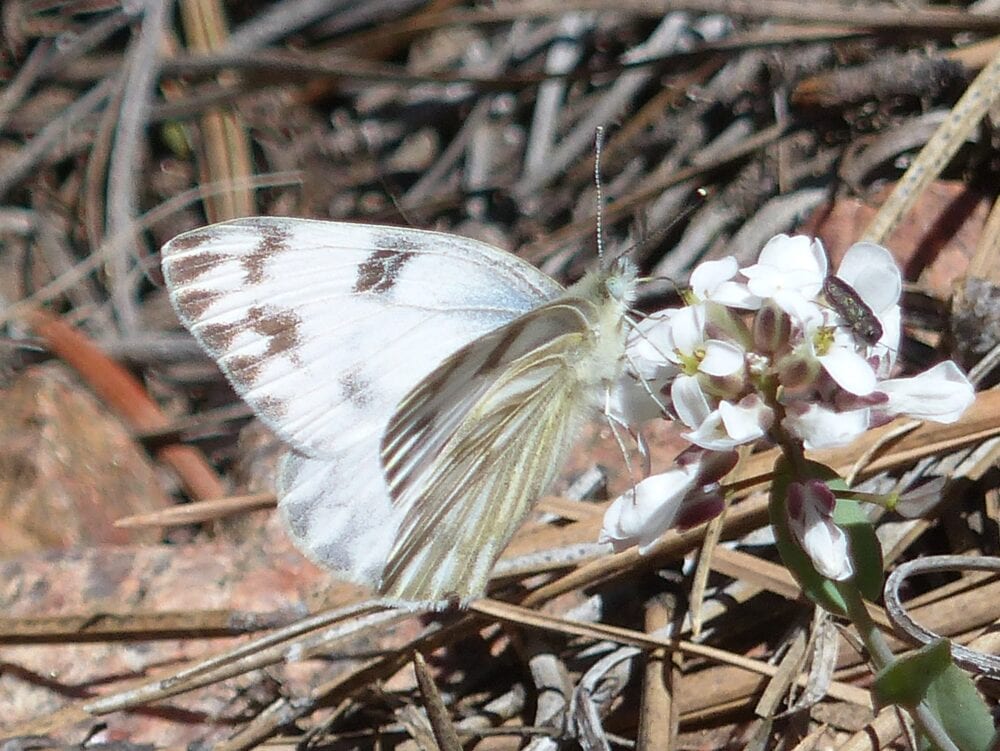

A good starter hill, or bump, lies within Rockhound State Park, adjacent to the main campground. Rockhound is a great butterflying destination because it includes a hilltop at the main camp area and a spring-fed ephemeral watercourse in the Spring Canyon unit at the north end of the Florida Mountains. There are lots of other places south of I-10, too, between Organ Mountain Desert Peaks National Monument and west all the way to and beyond the Arizona border. For hiking and butterflying, most of the sprawling BLM lands require no permits or fees. State Trust lands also are accessible for hiking and butterfly photography purposes if one acquires a recreational access permit for $35 (https://openforadventure.nmstatelands.org/). Mine just arrived in the mail for 2021.
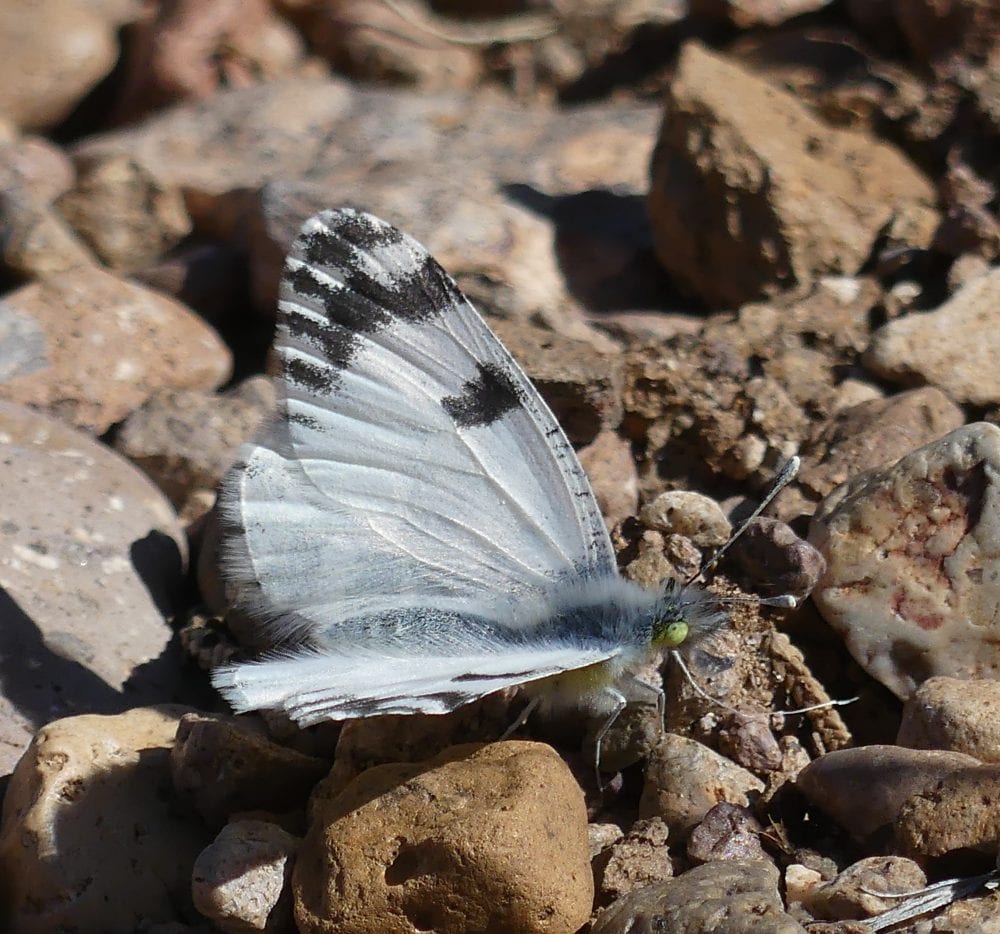

This multi-species, pheromone-choreographed dance, can be a spectacle if enough males are involved. Males of each of these species believe that the top of the hill is the best place to seek out and find females. If no female comes along after a few minutes the male will fly off, do some irregular laps around the summit, showing his flag and looking for love. This search method can continue all day, with males actively searching, then chasing anything that moves hoping it might be a female. Often it is another male and each tries to chase the other off of the summit. This is fascinating to watch, but it can render an average butterfly photographer (me, for example) rather frustrated as I wait for one to settle so I can take a photo. After an hour of frustration, I put the camera at arm’s length and begin following zigzagging butterflies and clicking away trying to photograph each as it flies by. Results are usually poor and humorous (see below), and I’ll skip the blurry shots of air only.
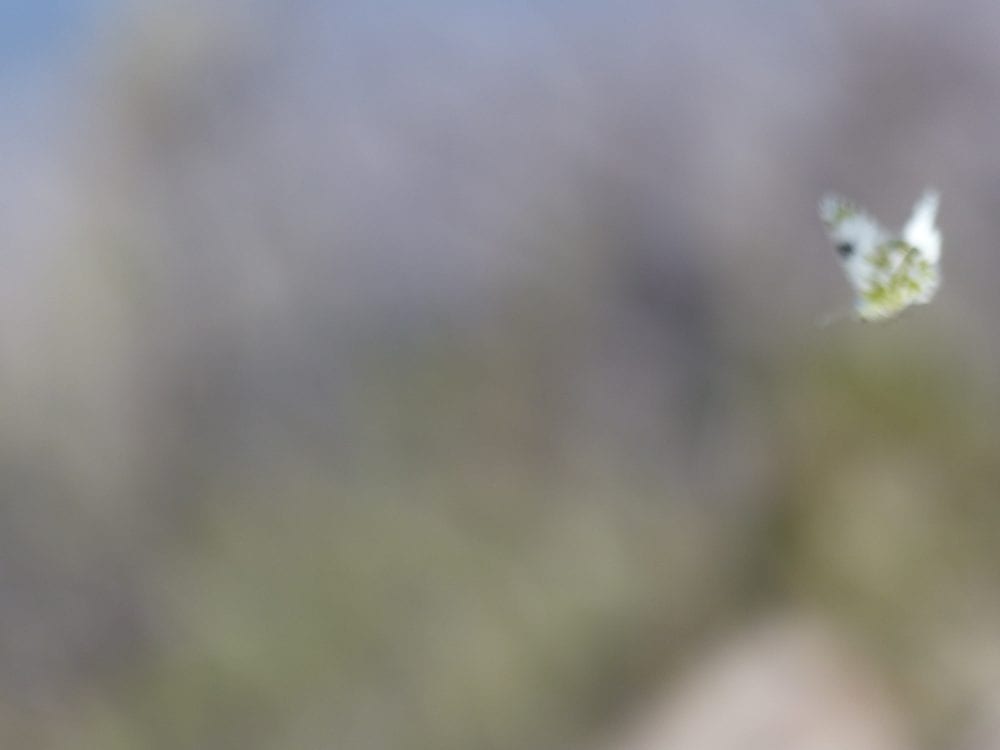

Sometimes there’s even a parade. In the case below, I suspect the leader is a female Desert Marble with two males of that species in pursuit. Chasing all three is a male Checkered White.
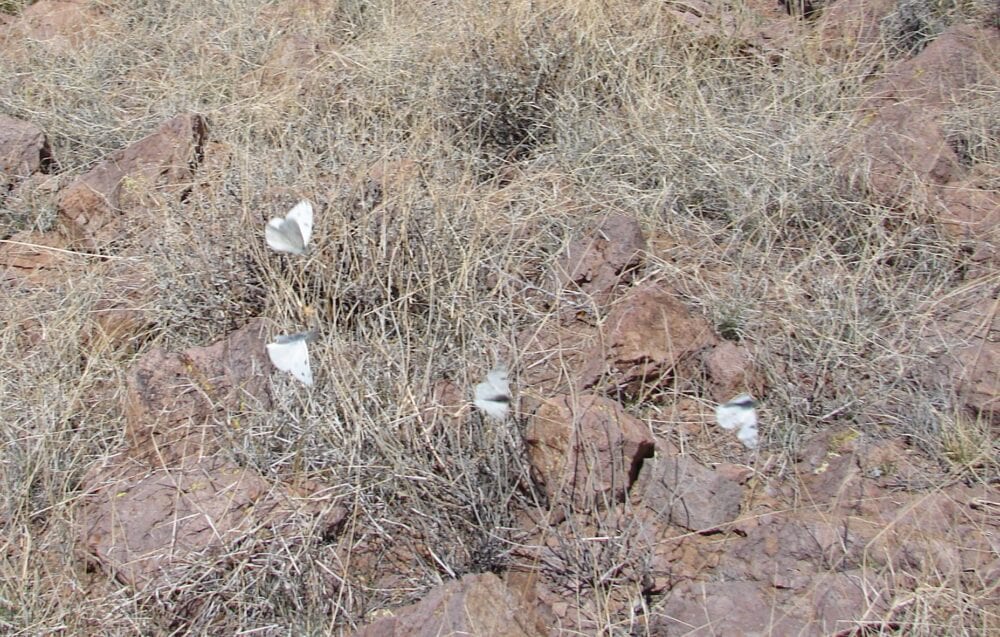

Photos of butterflies on parade are OK, even cool in an unfocused, stop-action kind of way. I suppose a good videographer could make something of the hilltop maelstrom, which it can be at times. Nevertheless, preferring stationary subjects, I figured out a way to slow them down. Instead of going up to the hilltop early in the morning when they are most caffeinated, I waited until it was time for them to call it a day. It was about 3:00 PM on March 25, 1989; under a blue sky, the spring sun was already in decline, the air temperature was no longer holding at “warm,” so a male Spring White and a male Southwestern Orangetip abandoned their restless hilltop patrolling and coasted downslope, toward the east where they positioned themselves to catch sun first thing the next morning. I followed them at a safe distance and at the base of the hill they settled, still in sunshine, but much more sedate. With a camera in-hand, I could not approach from uphill because my shadow would fall over them, so I ambled around to the downhill side and approached them from below. I had to point my camera into the sun, unfortunately, but I got some good closeups, and backlighting can be beneficial because it illuminates interior wing surfaces. Those shots are now grungy, old slides (see below), but the strategy should still work.


This hilltop Pierid rodeo is a unique and wonderful bit of butterfly natural history in the Southwest. It really makes me appreciate the adaptations native plants and insects must have in order to make a living over the long term. However, the big dance does require decent winter moisture, without which the mustards and their butterfly herbivores all simply remain in diapause for another year. How many years can they extend diapause? No one really knows for these particular species because the research has not been done, but if native plants can wait several years for a wet winter, I’m confident their herbivores can wait just as long. Despite all the multi-year droughts the region has experienced in just the past 20 years, all those species are still there, patiently hoping for 2021, but willing to wait if necessary.
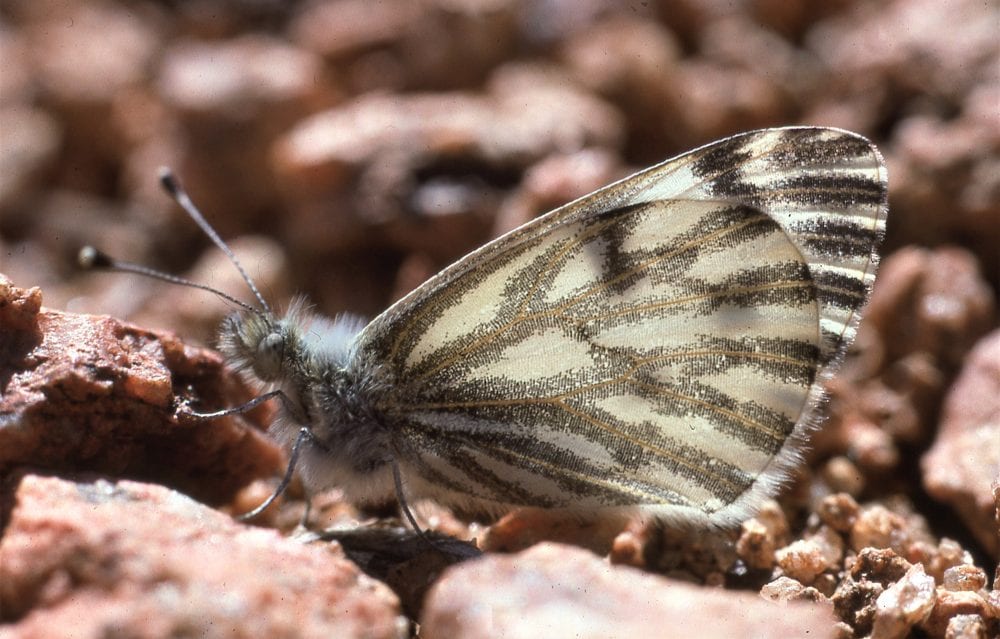

This annual hilltopping event is not glorious every year. The size of the butterfly rodeo, the number and diversity of butterfly participants, depends on the number and diversity of native mustards that are going about their own phenological sequence of growth, bloom, pollination, seed-set, and senescence. All native plants, at least those that are annuals or shallow-rooted perennials, know better than to embark on reproduction when the soil is dry-as-dust; they will be unable to complete the process, and their very survival could be at risk. Dry soil means few plants (specifically, few larval host plants) and therefore few butterflies, who depend on plants for food: nectar for themselves and solid tissues for larvae. Contrarily, after a wet winter, soils are damp, plants are happy, and their native herbivores are taking note. Collectively all are set to ‘get busy’ when warm weather arrives. That’s when we see sprawling fields of yellow New Mexico poppies, purple scorpionweeds, orange globemallows, blue lupines, and mustards, too: purple, white, and yellow. That’s when the desert Pierids come out of chrysalids and launch their reproductive activities.
What will we have this spring, from Lordsburg to Las Cruces? Check the US Drought Monitor and draw your own conclusions, but data as of March 11 show “extreme” and “exceptional” drought for that area. It does not look promising for spring 2021. The needed 2-inch rain could come at any time, though it better hurry. Of course, most years are in the middle somewhere, neither severely parched nor lusciously moist. In most years you can check out the desert hilltops and find some activity, not the all-out rodeo, but at least a few critters, and that may offer some advantages for purposes of observation and photography.
It is true that most of these hilltopping spring whites occur more widely across New Mexico. You don’t have to go to the Bootheel to see Southwestern Orangetip or Spring White, and Desert Marble lives in northwest New Mexico, too. As for Checkered White . . . good luck dodging them! Wherever you find them, check out the hilltops. To see Desert Orangetip, however, one must go to I-10. That could be a long drive for many of us, so keep in mind that this five-species circus follows wet winters and coincides with significant desert blooms of spring wildflowers, making it a 2-for-1 deal. Many people go to see just the mega-bloom, but butterflyers get to appreciate the Lepidoptera angle, too. Put it on your calendar, but be prepared to postpone if conditions dictate, then try again the next year.
May your 2021 butterfly season commence soon and be successful!

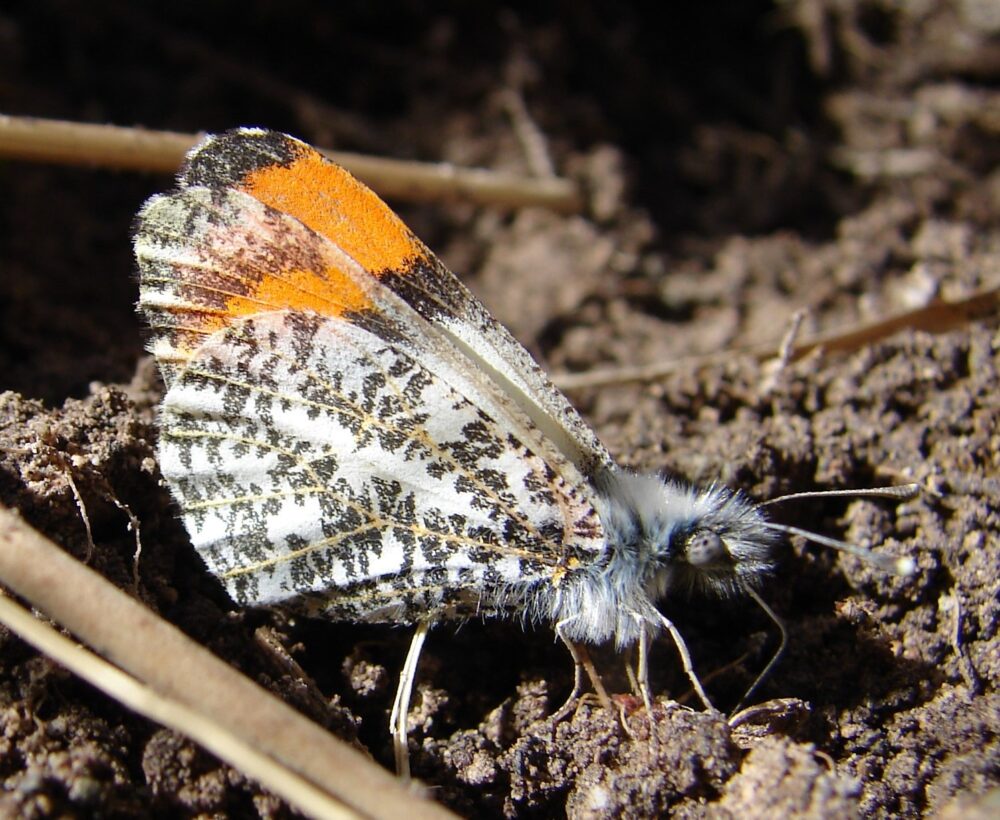
Hi Mr. Cary – a friend sent me a copy of your butterfly quest notes and request for images (your images are remarkable)! In the last couple of years, while focusing on wildflower/potential pollinator image collection in the Las Cruces area, I have also collected butterfly images. Some favored sites are Observation Hill in the Chihuahuan Desert Nature Park (late March – confluence of Dona Ana Mtns. and Jornada del Muerto plain), Tortugas Mountain (seasonal March through September/October), and along the Rio Grande (seasonal – high numbers use the milkweed flowers June-August/September, in particular). Several images may be of sufficient quality for consideration in your statewide project (in terms of clarity and image pixel density).
I’m happy to send a few examples if you have the time and interest to review and comment. Please let me know…
Steve, I enjoyed this article very much. Thank you for sharing your knowledge about butterfly behavior. I’ll be looking for hilltops this spring.
thanks, Rebecca, good luck! Once mated, females will be down along drainages looking in the shadows for mustards. And, I have an idea regarding your efforts last year to see Megathymus (ursus) violae. I steered you to high peaks in the Manzanos, but in retrospect that was not the best idea, at the extreme north limit of its range and probably a stray of some kind. That bug is a Chihuahuan Desert inhabitant so your time might be better spent searching in Eddy, Otero and Dona Ana counties, June and July I think. In case you decide to try again . . .
Steve – great essay. I thought I’d add that I’ve had good luck with Southwestern Orangetips while hiking up Atalaya Peak in Santa Fe. I found groups of them on the lower slopes of Atalaya in early April 2013, which must have been a wet year.
thanks, Bernie. nice to hear from you. thanks for sharing your observations!